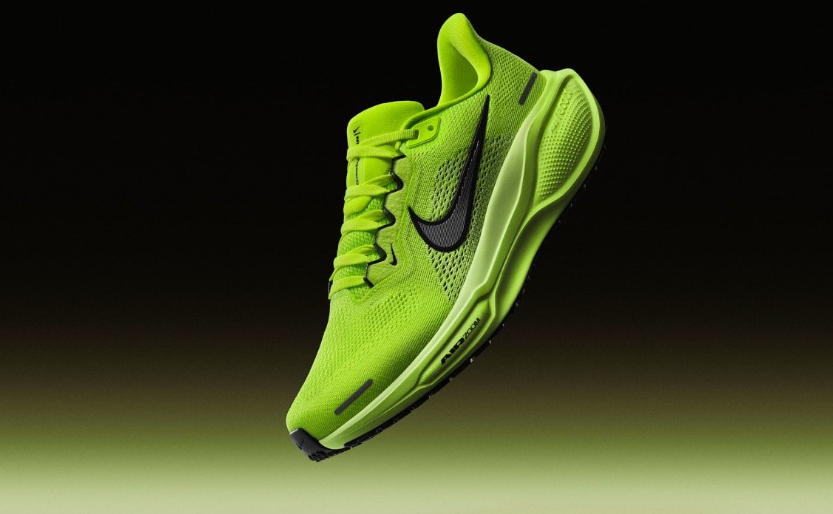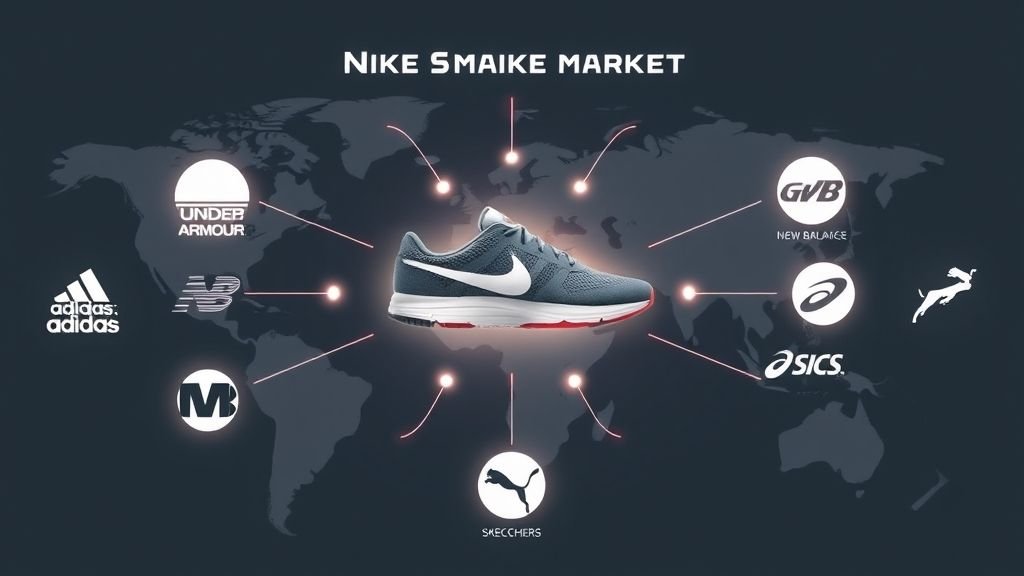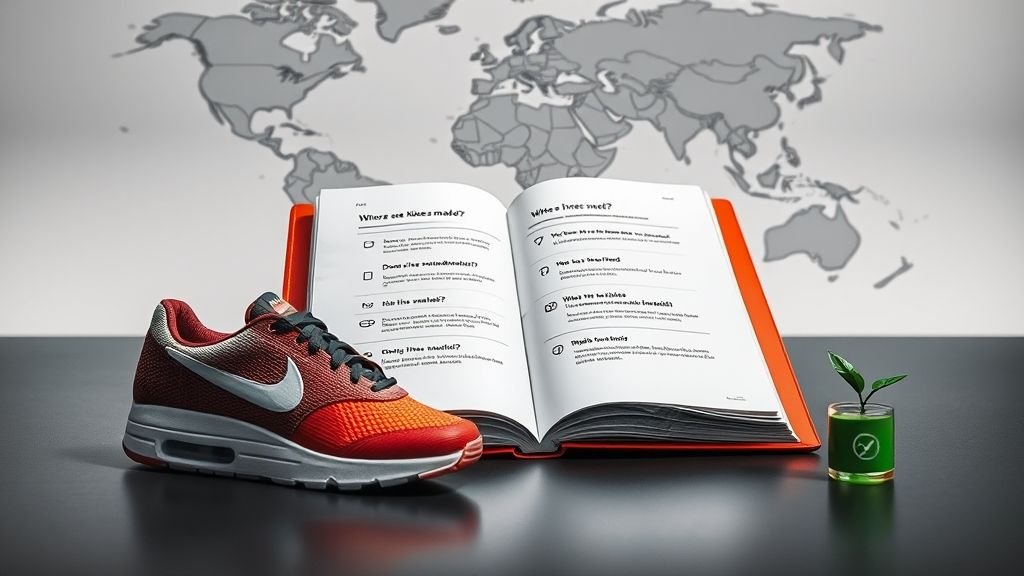Are you curious about where Nike produces its massive volume of shoes and apparel? It's a complex global network. Nike, a global leader in athletic footwear and apparel, operates a vast global manufacturing network. They do not own most of their manufacturing facilities directly. Instead, they partner with independent contract factories primarily located in Asia, with Vietnam, Indonesia, and China being key production hubs for the majority of their shoes and apparel.
As someone navigating the global footwear supply chain with Lucas since 1998, I've observed firsthand how giants like Nike manage their production. Their strategy is a masterclass in globalized manufacturing, focusing on strategic partnerships rather than direct ownership. This allows them immense flexibility and scalability.
Where Are Nike Shoes Made?
Are you wondering about the specific locations where Nike's iconic shoes are manufactured? It's a key question for understanding their supply chain.
Nike manufactures the vast majority of its footwear in Asia, relying heavily on contract factories in Vietnam, Indonesia, and China. Vietnam consistently produces the largest share of Nike shoes, followed by Indonesia and then China, reflecting a strategic diversification of their manufacturing footprint.
 Having been in the footwear manufacturing business for over two decades, I know that large-scale shoe production is a delicate balance of cost, quality, and logistics. Nike's approach demonstrates this perfectly. They leverage the unique strengths of various countries to meet their massive global demand.
Having been in the footwear manufacturing business for over two decades, I know that large-scale shoe production is a delicate balance of cost, quality, and logistics. Nike's approach demonstrates this perfectly. They leverage the unique strengths of various countries to meet their massive global demand.
The Global Footprint of Nike's Shoe Production
Nike's production strategy emphasizes efficiency and flexibility by utilizing a distributed network of contract factories. This approach helps them manage costs, respond to trade dynamics, and ensure a continuous supply.
- Vietnam: The Primary Hub: Vietnam has consistently been Nike's largest footwear manufacturer for many years. Its appeal lies in competitive labor costs, a skilled workforce, and a stable political environment. The country has developed a robust supply chain ecosystem for athletic footwear, attracting significant foreign investment from major brands like Nike. Factories in Vietnam produce a wide range of Nike's athletic and lifestyle shoes, from running shoes to basketball sneakers.
- Indonesia: A Strong Contender: Indonesia ranks as Nike's second-largest footwear producer. It offers similar advantages to Vietnam, including a large workforce and relatively competitive wages. Many long-standing Nike supplier relationships are based here. Indonesian factories contribute significantly to Nike's output, producing various styles, often complementing the production lines in Vietnam.
- China: Shifting Focus: While China was historically Nike's dominant manufacturing location, its role has evolved. Due to rising labor costs and Nike's strategy of supply chain diversification, China now accounts for a smaller percentage of Nike's total footwear production compared to Vietnam and Indonesia. However, China remains crucial for certain specialized products, higher-tech manufacturing processes, and as a source for materials and components. Its advanced infrastructure and comprehensive supply chain still offer unique advantages.
- Other Locations: Nike also has smaller manufacturing presences in other countries, though their contribution to total footwear volume is significantly less than the top three. These might include places like India, which is growing in its manufacturing capabilities, or some Western economies for highly specialized or automated processes, though these are typically not for mass production.
Nike's reliance on independent contract factories means they can scale production up or down more easily, and leverage the expertise of established manufacturers without the overhead of owning and operating every plant. This is a common strategy among large global brands seeking maximum efficiency and responsiveness in their supply chains.
| Country | Primary Role in Nike's Footwear Production | Key Advantages for Nike |
|---|---|---|
| Vietnam | Largest footwear producer for Nike; wide range of styles. | Competitive labor costs, skilled workforce, established supply chain. |
| Indonesia | Second-largest footwear producer; significant volume. | Large labor pool, competitive wages, long-term partnerships. |
| China | Specialized production, high-tech, materials sourcing. | Advanced infrastructure, comprehensive supply chain, component sourcing. |
| Other | Smaller scale, specific product lines, emerging markets. | Diversification, niche production, regional market access. |
Materials Used in Nike Shoes? Are you curious about the materials that make up Nike's innovative shoes? They're constantly evolving. Nike extensively uses a diverse range of materials, integrating both traditional and advanced synthetics, often with a growing focus on sustainability. Key components include engineered mesh, Flyknit, and various synthetic leathers for uppers; Phylon, EVA foam, and rubber for midsoles and outsoles; and recycled materials for a lighter environmental footprint.
As a shoe manufacturer, I'm always observing material innovation. Nike is at the forefront of combining performance, durability, and increasingly, sustainability, in their material choices. Their proprietary technologies are built upon a foundation of clever material engineering.
The Building Blocks of Nike Footwear
Nike's material strategy is about merging performance with innovation. They often create proprietary materials or processes to gain an edge.
- Uppers: Engineered for Performance and Comfort:
- Engineered Mesh: This is a very common material, often used in running shoes. It's a synthetic fabric with varying weaves to offer breathability, support, and flexibility in targeted areas. It's lightweight and adapts well to the foot.
- Flyknit: A revolutionary technology where the entire upper is knitted from polyester yarns, creating a lightweight, form-fitting, and virtually seamless construction. This process significantly reduces material waste compared to traditional cut-and-sew methods.
- Synthetic Leathers and Overlays: Nike uses various synthetic leathers (often polyurethane-based) and TPU (thermoplastic polyurethane) overlays for durability, support, and structural integrity. These materials are lighter and more consistent than natural leather and can be engineered for specific properties.
- Midsoles: Cushioning and Energy Return:
- Phylon (EVA Foam): This is a lightweight, responsive foam derived from EVA (ethylene-vinyl acetate) pellets that are heat-compressed and then cooled. Phylon is very common for cushioning in many Nike shoes, providing a soft and comfortable ride.
- Nike Air Technology: This is a system of pressurized air encased in a durable, flexible membrane, strategically placed within the midsole. It provides lightweight cushioning and impact absorption, protecting the body from the forces of sport. Variations include Zoom Air (responsive, low-profile) and Max Air (maximum cushioning).
- React Foam: A relatively newer proprietary foam that is specifically engineered to be soft, lightweight, durable, and highly responsive. It offers an excellent balance of cushioning and energy return.
- Outsoles: Traction and Durability:
- Rubber: Various formulations of durable rubber are used for the outsole to provide traction and resist abrasion. Different patterns and rubber compounds are used depending on the shoe's intended use (e.g., running, basketball, training).
- Recycled Rubber: In line with their sustainability goals, Nike increasingly incorporates recycled rubber (often from factory waste or old shoes) into their outsoles, blending it with virgin rubber to maintain performance standards.
- Sustainability Focus: Nike's "Move to Zero" initiative emphasizes the use of recycled content like recycled polyester (from plastic bottles), recycled rubber, and efforts to reduce waste in manufacturing processes, reflecting a broader industry trend towards more circular materials.
Nike's material choices are carefully selected and often highly engineered to deliver on performance promises, whether it's lightweight speed, robust durability, or supreme cushioning.
| Shoe Component | Primary Materials Used (Examples) | Key Function/Advantage |
|---|---|---|
| Upper | Engineered Mesh, Flyknit, synthetic leathers, TPU overlays. | Breathability, support, lightweight, form-fitting. |
| Midsole | Phylon (EVA), Nike Air (pressurized gas), React foam. | Cushioning, impact absorption, energy return, responsiveness. |
| Outsole | Various rubber compounds, recycled rubber. | Traction, durability, abrasion resistance. |
| Lining | Textile fabrics (often recycled polyester). | Comfort, moisture-wicking. |
| Laces | Polyester, cotton blends. | Secure fit. |
Nike's Competitors in the Footwear Industry?
Are you wondering who challenges Nike's dominance in the global footwear market? The competition is intense and varied.
Nike faces strong competition from global giants like Adidas, Puma, and Under Armour, as well as specialized brands such as New Balance, Skechers, and ASICS. Additionally, emerging direct-to-consumer athletic brands and fashion-forward lifestyle labels pose increasing challenges across various market segments.
 From my perspective in the footwear supply chain, the global market is fiercely competitive. Every brand, including Lucas, is vying for consumer attention. Nike's position is powerful, but they operate in a dynamic landscape with many innovative players.
From my perspective in the footwear supply chain, the global market is fiercely competitive. Every brand, including Lucas, is vying for consumer attention. Nike's position is powerful, but they operate in a dynamic landscape with many innovative players.
The Major Players in the Footwear Arena
The competition for Nike can be broadly categorized into several groups, each with its unique strengths and market approach.
- Global Athletic Powerhouses:
- Adidas: Nike's primary and most direct competitor. Adidas, based in Germany, has a massive global presence, a strong history in performance sports, and a significant lifestyle segment. They compete directly with Nike in categories like running, basketball, and fashion sneakers, featuring their own innovations like Boost and Primeknit.
- Puma: Also a German brand, Puma has staged a significant comeback, especially in the lifestyle and fashion-athletic segments. They leverage collaborations with celebrities and designers and have a strong heritage in sports like football (soccer) and motorsport.
- Under Armour: Based in the U.S., Under Armour focuses heavily on performance athletic apparel and footwear. They target serious athletes and training enthusiasts, competing with Nike in specific sports categories like training, American football, and basketball.
- Specialized and Niche Athletic Brands:
- New Balance: Known for its focus on comfort, fit, and innovation, particularly in running shoes and lifestyle sneakers. New Balance has a dedicated following and often emphasizes domestic manufacturing in the U.S. and U.K.
- ASICS: A Japanese brand renowned for its performance running shoes. ASICS is highly regarded by serious runners for its GEL cushioning technology and biomechanical research, standing as a strong competitor in the technical running segment.
- Skechers: This U.S. brand focuses on comfort and a broader demographic, offering a wide range of casual, athletic, and lifestyle footwear at various price points. They have gained significant market share, especially in everyday wear and walking shoes.
- Emerging Direct-to-Consumer (DTC) and Lifestyle Brands:
- The rise of DTC brands, like Hoka One One (now part of Deckers Brands, but with a strong vertical approach), Allbirds, and On Running, challenges traditional giants by focusing on specific niches (e.g., maximal cushioning, sustainable materials) and building direct relationships with consumers.
- Fashion-forward brands that blend athletic aesthetics with high fashion also compete for wallet share, pulling consumers who might otherwise buy Nike lifestyle products.
Nike maintains its leading position through continuous innovation, powerful marketing, extensive sponsorships, and a deep connection with sports culture. However, the diverse and ever-evolving competitive landscape means they must constantly adapt and innovate to stay ahead.
| Competitor Group | Key Strengths | Examples of Brands | Primary Competitive Arena Against Nike |
|---|---|---|---|
| Global Athletic Giants | Broad product lines, massive marketing, innovation capacity. | Adidas, Puma, Under Armour | Running, basketball, lifestyle, apparel, football. |
| Specialized Athletic | Niche focus, technical expertise, specific consumer loyalty. | New Balance, ASICS, Skechers | Running, walking, casual, specific sport segments. |
| DTC & Lifestyle Brands | Agility, direct consumer connection, focused product offerings. | Hoka, Allbirds, On Running, independent designers | Sustainability, specific performance niches, fashion trends. |
Frequently Asked Questions?
Are you looking for quick answers to common questions about Nike's manufacturing and operations? Here are some insights.
Here are answers to frequently asked questions about Nike, covering topics from their manufacturing base and ethical practices to their business model and environmental commitments. These insights offer a clearer picture of how Nike operates on a global scale.
 In my two decades in the footwear industry, discussions around Nike's operations often come up. It is important to know the facts about a brand of this size. I have compiled some of the most common questions and provided answers based on industry knowledge and publicly available information.
In my two decades in the footwear industry, discussions around Nike's operations often come up. It is important to know the facts about a brand of this size. I have compiled some of the most common questions and provided answers based on industry knowledge and publicly available information.
Common Inquiries About Nike's Production and Business
Navigating the complexities of a global brand like Nike can raise many questions. Here I aim to provide clear answers.
- Does Nike own its factories?
- No, Nike primarily operates on a "asset-light" model. They do not typically own the manufacturing facilities. Instead, they partner with a large network of independent contract factories, mainly in Asia. This allows Nike to outsource the capital investment and operational management of manufacturing, giving them flexibility in scaling production and adapting to market changes. My company, Lucas, operates similarly, partnering with BSCI, SEDEX-certified factories to meet brand standards, ensuring quality and ethical compliance without direct factory ownership.
- Is Nike a sustainable company?
- Nike has made significant commitments and investments in sustainability, particularly through its "Move to Zero" initiative, aiming for a zero-carbon and zero-waste future. They actively incorporate recycled materials (like recycled polyester and rubber), develop energy-efficient manufacturing processes, and invest in renewable energy for their operations. However, like any large global company, they face ongoing challenges in achieving full circularity and transparency across their entire vast supply chain, and they regularly publish sustainability reports outlining their progress and goals.
- How does Nike ensure ethical labor practices in its contract factories?
- Nike has a comprehensive Code of Conduct that all its contract factories must adhere to, covering areas like fair wages, safe working conditions, and respecting workers' rights. They conduct regular audits through third-party organizations and their own internal teams to monitor compliance. While challenges can arise in such a large supply chain, Nike states its commitment to continuous improvement and works with labor rights organizations to address issues when they are identified. Certifications like BSCI and SEDEX, which Lucas adheres to through its partner factories, are crucial for demonstrating these commitments.
- What is Nike's business model?
- Nike's core business model revolves around the design, development, marketing, and sales of athletic footwear, apparel, and accessories. They focus heavily on branding, innovation (e.g., responsive cushioning technologies, sustainable materials), and direct consumer engagement through their stores and digital platforms. They leverage strategic sponsorships with athletes and teams, and their outsourced manufacturing model enables global reach and cost efficiency.
- How does Nike manage its supply chain risks?
- Nike manages supply chain risks through diversification of its manufacturing base (e.g., spreading production across Vietnam, Indonesia, China), investing in technology to improve supply chain visibility, and building strong, long-term relationships with key contract manufacturers. They also employ robust inventory management systems and contingency planning to mitigate disruptions from geopolitical events, natural disasters, or other unforeseen circumstances.
Nike's operations are complex, reflecting its status as a global leader. Their approach combines technological innovation, strategic outsourcing, and a growing commitment to corporate responsibility.
Conclusion Nike largely manufactures shoes in Asia, mainly Vietnam, Indonesia, and China, using advanced materials and sustainable practices. They face strong competition from global athletic brands and emerging DTC players while navigating the complexities of a vast, outsourced supply chain and upholding ethical standards.
